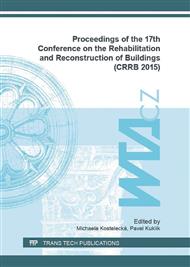[1]
S.H. Han, W.S. Park, E.I. Yang, Evaluation of concrete durability due to carbonation in harbor concrete structures, Construction and Building Materials. 48 (2013) 1045-1049.
DOI: 10.1016/j.conbuildmat.2013.07.057
Google Scholar
[2]
B.G. Salvoldi, H. Beushasen, M.G. Alexander, Oxygen permeability of concrete and its relation to carbonation, Construction and Building Materials 85 (2015) 30-37.
DOI: 10.1016/j.conbuildmat.2015.02.019
Google Scholar
[3]
D. Chopra, R. Siddique, Strength, permeability and microstructure of self-compacting concrete containing rice husk ash, Biosystems Engineering 130 (2015) 72-80.
DOI: 10.1016/j.biosystemseng.2014.12.005
Google Scholar
[4]
G. Roventi, T. Bellezze, G. Giuliani, C. Conti, Corrosion resistance of galvanized steel reinforcements in carbonated concrete: effect of wet–dry cycles in tap water and in chloride solution on the passivating layer, Cement and Concrete Research 65 (2014).
DOI: 10.1016/j.cemconres.2014.07.014
Google Scholar
[5]
J.L.S. Ribeiro, Z. Panossian, S.M.S. Selmo, Proposed criterion to assess the electrochemical behavior of carbon steel reinforcements under corrosion in carbonated concrete structures after patch repairs, Construction and Building Materials 40 (2013).
DOI: 10.1016/j.conbuildmat.2012.09.097
Google Scholar
[6]
J.J. Chen, A.K.H. Kwan, Y. Jiang, Adding limestone fines as cement paste replacement to reduce water permeability and sorptivity of concrete, Construction and Building Materials 56 (2014) 87-93.
DOI: 10.1016/j.conbuildmat.2014.01.066
Google Scholar
[7]
L.M. Dellinghausen, A.L.G. Gastaldini, F.J. Vanzin, K.K. Veiga, Total shrinkage, oxygen permeability, and chloride ion penetration in concrete made with white Portland cement and blast-furnace slag, Construction and Building Materials 37 (2012).
DOI: 10.1016/j.conbuildmat.2012.07.076
Google Scholar
[8]
L. Topolář, H. Šimonová, P. Misák. Effect of Concrete Mixture Composition on Acoustic Emission and Fracture Parameters Obtained from Three-Point Bending Test, Advanced Materials Research 100 (2015) 152-155.
DOI: 10.4028/www.scientific.net/amr.1100.152
Google Scholar
[9]
M. Matysík, L. Topolář, P. Daněk, H. Šimonová, T. Vymazal, I. Plšková, An Experimental Study on Acoustic Emission Signals during the Three-Point Bending Fracture Test, Advanced Materials Research 1000 (2014) 281-284.
DOI: 10.4028/www.scientific.net/amr.1000.281
Google Scholar
[10]
B. Kucharczyková, P. Misák, T. Vymazal, Determination and evaluation of the air permeability coefficient using Torrent Permeability Tester, Russian Journal of Nondestructive Testing 46 (2010) 226-233.
DOI: 10.1134/s1061830910030113
Google Scholar
[11]
Construction en béton –Spécifications complémentaires: Annexe E: Perméabilité à l'airdans les structures,. Switzerland: NS, (2003).
Google Scholar
[12]
Recommendation of RILEM TC 189-NEC Non-destructive evaluation of the concrete cover,: Comparative test - Part I, Materials and Structures 38 (2005) 895-906.
DOI: 10.1617/14432
Google Scholar
[13]
P.A. Claisse, Surface tests to determine transport properties of concrete – I: the tests. Transport Properties of Concrete (2014) 26.
DOI: 10.1533/9781782423195.26
Google Scholar
[14]
B.B. Sabir, S. Wild, M. O'Farrell, A water sorptivity test for mortar and concrete. Materials and Structures 31 (1998) 568-574.
DOI: 10.1007/bf02481540
Google Scholar
[15]
Testing concrete. Method for determination of water absorption. UK: BSI, (2011).
Google Scholar
[16]
Nondestructive testing of materials and structures: proceedings of NDTMS-2011, Istanbul, Turkey, (2011).
Google Scholar
[17]
Testing fresh concrete - Part 1: Sampling. CEN, (2009).
Google Scholar
[18]
Testing fresh concrete - Part 2: Slump-test. CEN, (2009).
Google Scholar
[19]
Testing fresh concrete - Part 5: Flow table test. CEN, (2009).
Google Scholar
[20]
Testing fresh concrete - Part 6: Density. CEN, (2009).
Google Scholar
[21]
Testing fresh concrete - Part 7: Air content - Pressure methods. CEN, (2009).
Google Scholar
[22]
Eurocode: Basis of structural design. CEN (2015).
Google Scholar
[23]
L. Eriksson, Design of experiments: principles and applications, Umetrics Academy, Umeå, (2008).
Google Scholar
[24]
M. Fritz, P. D. Berger, Comparing more than two means. Improving the User Experience Through Practical Data Analytics (2015) 163-168.
DOI: 10.1016/b978-0-12-800635-1.00007-0
Google Scholar


